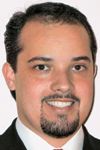Article
Study: High IOP linked to RNFL loss in progression of glaucoma
Elevated IOP accelerates retinal nerve fiber layer (RNFL) loss and increases the risk that glaucoma will progress, according to an observational cohort study of 204 patients recruited from the Diagnostic Innovations in Glaucoma Study.

Key Points

He and his colleagues conducted an observational cohort study to evaluate the relationship between IOP and progressive RNFL loss in a cohort of patients with glaucoma and individuals suspected of having the disease.
Patients were followed over time, and longitudinal changes in the RNFL as measured by a scanning laser polarimeter (GDx ECC, Carl Zeiss Meditec) were compared with changes detected by conventional methods, including standard automated perimetry and optic disc stereophotographs.
Dr. Medeiros, along with Robert N. Weinreb, MD, the Distinguished Professor of Ophthalmology, University of California, San Diego, and their colleagues studied 344 eyes of 204 patients recruited from the Diagnostic Innovations in Glaucoma Study.
Ninety-eight eyes (28%) had a diagnosis of glaucoma, as determined by the presence of repeatable visual field defects. An additional 246 eyes (72%) were considered to have suspected glaucoma because of a high IOP or questionable optic nerve hypoplasia appearance at baseline.
The patients were followed for 5 years. Images were obtained annually with the scanning laser polarimeter along with optic disc stereophotographs and standard automated perimetry. The study included a total of 1,211 polarimeter visits, with an average of 3.5 visits per eye.
Progression was determined by proprietary software (Guided Progression Analysis, Carl Zeiss Meditec) for standard automated perimetry and by masked assessment of stereophotographs performed by expert graders.
Twenty-nine eyes (8%) showed progression over time on visual fields and/or optic disc stereophotographs.
The rate of RNFL loss in eyes with progression (–0.95 µm or 2%, per year) was significantly larger than that of eyes without progression (–0.17 µm or 0.3%, per year), after adjusting for IOP and central corneal thickness (p = 0.001).
Each 1 mm Hg increase in IOP was associated with an additional loss of 0.05 µm per year of RNFL. Among patients in whom glaucoma progressed, each 1 mm Hg increase in IOP was associated with an additional loss of 0.13 µm per year of RNFL (p = 0.001).
Among the eyes with progression, the rates of change were greater in the inferior and superior sectors; there was basically no change in the temporal sector and very little change in the nasal sector.
"In recent years we have seen the results of a number of clinical trials in glaucoma that have given us a new perspective about the role of IOP in development and progression of the disease," Dr. Medeiros said. "Most of these clinical trials have used visual fields as the sole end point to determine progression. But in many patients, nerve fiber layer changes often provide evidence of progression before any changes are evident in visual fields. In fact, at the earliest stages of the disease, changes in nerve fiber layers can be the only sign of progression."
He added that although structural evaluation of the optic nerve has been used as an endpoint in some studies, it generally has been performed by subjective assessment of color stereophotographs and has not included an evaluation of RNFL changes.
According the Dr. Medeiros, by relating IOP to changes in the RNFL detected by the scanning laser polarimeter, this study also suggests that scanning laser polarimetry may be helpful in monitoring progression and estimating rates of change in patients with glaucoma or suspected of having the disease.
"These findings suggest that the change we're seeing in this instrument is a true change," he said.
Newsletter
Don’t miss out—get Ophthalmology Times updates on the latest clinical advancements and expert interviews, straight to your inbox.




